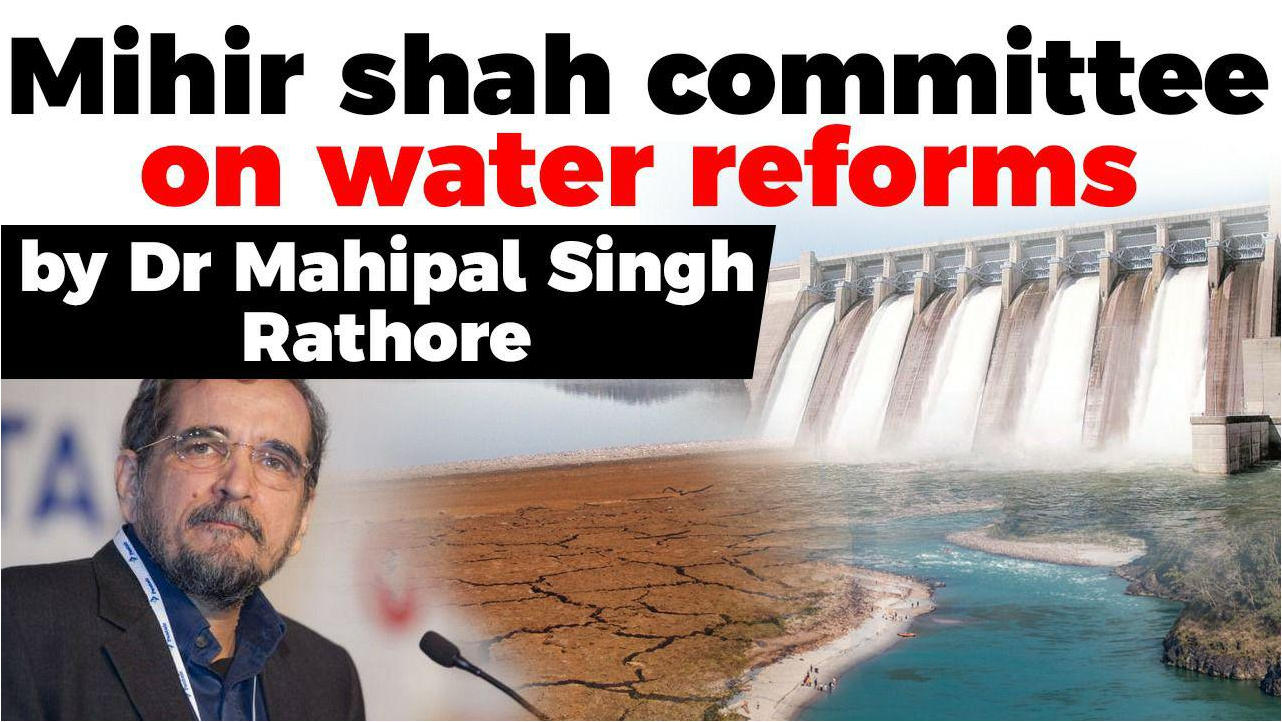Table of Contents
Who is Mihir Shah?
- Mihir Shah is an Indian economist and former member of the erstwhile Planning Commission of India
- 2009-2014 – In the commission, he held the portfolios of Water Resources, Rural Development and Decentralised Governance.
- An expert on water and rural development.

- There 2 Mihir shah committees!
- Be alert!
Why in news?
- The Ministry of Jal Shakti recently constituted a committee to draft a new National Water Policy (NWP).
Composition of the committee –
- It will be chaired by Mihir Shah
- Comprising of 10 principal members.
- First time ever that someone from outside the govt.is chairing the NWP farming committee
Q.1 Ministry of Jal Shakti was formed in 2019 by combining which two erstwhile ministries?
Q.2 Who is the MoS of Jal Shakti ministry?
Why a new water policy?
- NWP was formulated to govern the planning and development of water resources and their optimum utilisation.
- The first NWP was adopted in September 1987.
- It was reviewed and updated in 2002 and later in 2012.
- A new NWP will recommend key changes in water governance structure and regulatory framework.
Changing needs of the nation –
- A growing population
- Rising needs of a developing nation
- The looming uncertainty of climate change.
- Conflicts could increase in future.
- Availability of utilisable water is coming under strain
- The water that lies stored in our dams is not reaching the farmers for whom it is meant
- Groundwater faces a crisis of sustainability
- Himalayan water source is decreasing
Key Features of National Water Policy, 2012
Integrated Water Resources Management
- It laid down the concept of an Integrated Water Resources
- Management approach that took the river basin/sub-basin as a unit for planning, development, and management of water resources.
- Integrated Water Resources Management (IWRM) is a process that promotes the coordinated development and management of water, land and related resources in order to maximize the resultant economic and social welfare in an equitable manner without compromising the sustainability of vital ecosystems.
- Emphasis on the need for a national water framework law, comprehensive legislation for optimum development of inter-State rivers and river valleys.
- Ecological needs of the river – A portion of river flows should be kept aside to meet ecological needs ensuring that the proportional low and high flow releases correspond in time closely to the natural flow regime.
- Water, after meeting the pre-emptive needs for safe drinking water and sanitation, achieving food security, supporting poor people dependent on agriculture and high priority allocation for eco-system needs, be treated as economic good so as to promote its conservation and efficient use.
- Setting up of Water Regulatory Authority has been recommended. Incentivization of recycle and re-use has been recommended.
- Water Users Associations should be given statutory powers to collect and retain a portion of water charges, manage quantum of water allotted to them and maintain the distribution system in their jurisdiction.
- Water resources projects and services should be managed with community participation. the private sector can be encouraged to become a service provider in PPP model.
The future challenges
Minimum Water Flow
- To maintain the minimum flow of a portion of a river to meet ecological needs.
- In 2018, such an approach led the government to require minimum water levels to be maintained in the Ganga throughout the year by refraining from hoarding water beyond a point.
- Emphasis to make a minimum quantity of potable water available to citizens for maintaining essential health and hygiene.
Inter-basin Transfers
- To meet basic human needs and achieve equity and social justice, inter-basin transfers of water need to be considered on the basis of the merits of each case after evaluating the environmental, economic and social impacts of such transfers.

- National Bureau of Water Use Efficiencyis proposed to be set up in order to enhance water usage efficiency, especially in domestic and industrial sectors.
The earlier Mihir shah Committee
- In 2015, The Ministry for Water Resources constituted a seven-member committee led by Mihir Shah
- To restructure the Central Water Commission (CWC) and the Central Ground Water Board (CGWB)
- To encourage optimal development of water resources in the country and recommend changes in water governance.
- 2016 report submitted.
- The report was titled
- “A 21st Century Institutional Architecture for India’s Water Reforms: Restructuring the CWC and CGWB”
What are CWC and CGWB?
- The CWC is responsible for coordinating with states for the implementation of schemes for the conservation and utilisation of water resources.
- The CGWB is responsible for assessment of ground water resources and implementation of policies for its sustainable management.
Recommendations
- The Committee recommended disbanding the CWC and CGWB to create a multi-disciplinary, unified and new National Water Commission (NWC).
- Greater involvement of social scientists, professionals from management and other specialised disciplines and reduce reliance on engineers.
- It reasoned that a unified body will help in the collective management of ground and surface water.
- The NWC will be responsible for water policy, data and governance in the country.
- It should be an adjunct office of the Ministry of Water Resources and function with full autonomy.
- Recommendations – Not implemented
- Major criticism from CWC






















 WhatsApp
WhatsApp